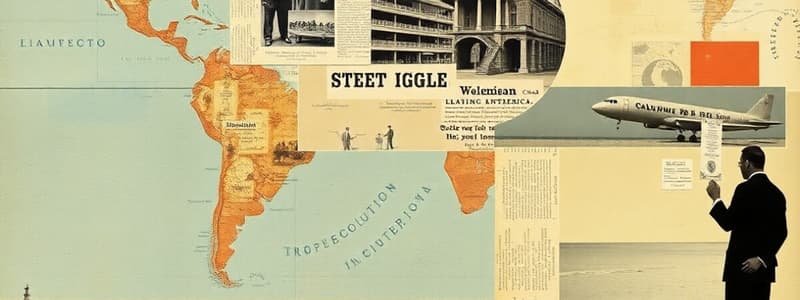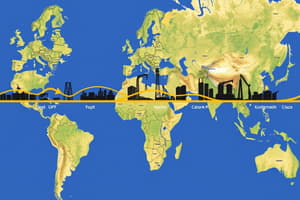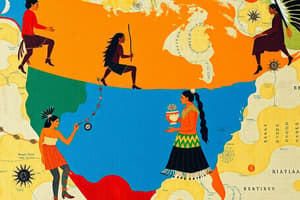Podcast
Questions and Answers
What climatic condition has influenced migration patterns in South America?
What climatic condition has influenced migration patterns in South America?
- High altitude conditions
- Lush rainforest environments
- Scorching climates of inland regions (correct)
- Mild temperatures of the Andes
Which of the following cities is located closer to the coast rather than in the interior of the continent due to migratory patterns?
Which of the following cities is located closer to the coast rather than in the interior of the continent due to migratory patterns?
- Santiago, Chile (correct)
- Asunción, Paraguay
- La Paz, Bolivia
- Madrid, Spain
What economic opportunity is available along the coastlines of the Caribbean that affects migration?
What economic opportunity is available along the coastlines of the Caribbean that affects migration?
- Fishing industries
- Agricultural development
- Tourism employment (correct)
- Mining opportunities
Which geographic feature influences the population concentration in South America?
Which geographic feature influences the population concentration in South America?
What role does climate play in migration within Central America?
What role does climate play in migration within Central America?
Which of these areas in South America has seen significant migration due to climate?
Which of these areas in South America has seen significant migration due to climate?
Why might a geographer indicate that coastal regions are more populated?
Why might a geographer indicate that coastal regions are more populated?
What is migration?
What is migration?
What geographical factors have influenced migration in the Caribbean and South America?
What geographical factors have influenced migration in the Caribbean and South America?
Which European nations were primarily involved in the colonization of the Caribbean, Central America, and South America?
Which European nations were primarily involved in the colonization of the Caribbean, Central America, and South America?
What was a significant impact of European migration on native populations in the Americas?
What was a significant impact of European migration on native populations in the Americas?
What term is used to describe the forced movement of a people group out of an area?
What term is used to describe the forced movement of a people group out of an area?
During the 1800s, which group of migrants moved to Peru and Bolivia to work in mines?
During the 1800s, which group of migrants moved to Peru and Bolivia to work in mines?
What motivated Europeans to migrate to the Caribbean, Central America, and South America?
What motivated Europeans to migrate to the Caribbean, Central America, and South America?
What impact did European colonization have on the economic systems of the Caribbean and South America?
What impact did European colonization have on the economic systems of the Caribbean and South America?
Flashcards
Migration definition
Migration definition
Movement of people from one place to another place
Forced Migration
Forced Migration
Forcibly moving a group of people out of an area
Geographical influence on migration
Geographical influence on migration
Climate, natural resources, and available land affect people's decision to move.
European colonization impact
European colonization impact
Signup and view all the flashcards
Natural resources & Migration
Natural resources & Migration
Signup and view all the flashcards
15th-century European Migration
15th-century European Migration
Signup and view all the flashcards
19th-century Asian Migration
19th-century Asian Migration
Signup and view all the flashcards
Climate and Migration
Climate and Migration
Signup and view all the flashcards
Chinatown in Lima
Chinatown in Lima
Signup and view all the flashcards
Population Concentration in South America
Population Concentration in South America
Signup and view all the flashcards
Atacama Desert's Influence
Atacama Desert's Influence
Signup and view all the flashcards
Coastal Cities and Climate
Coastal Cities and Climate
Signup and view all the flashcards
Caribbean Migration Pattern
Caribbean Migration Pattern
Signup and view all the flashcards
Central America's Population Distribution
Central America's Population Distribution
Signup and view all the flashcards
Climate as Migration Driver
Climate as Migration Driver
Signup and view all the flashcards
Study Notes
Migration Patterns in the Caribbean, Central America, and South America
- Migration is the movement of people from one place to another, often driven by escaping a poor situation or seeking better opportunities.
- Geographical factors, such as climate, strongly influence migration decisions. Warm winters in Arizona, for example, are a significant motivator for potential migration.
- Availability of natural resources and climate play significant roles in migration patterns in the Caribbean, Central America, and South America.
- European colonization significantly impacted migration in these regions.
- Europeans were attracted by natural resources and land in these areas, leading to large-scale migration. They often exploited existing resources and displaced native populations.
- Europeans' arrival resulted in the forced removal, enslavement, or annihilation of many indigenous people, known as forced migration.
- In the 1800s, Chinese migrants also moved to regions like Peru and Bolivia for work in mines, contributing to diverse communities.
- The presence of significant natural resources in the Andes Mountains and Argentina grasslands influenced European colonization and subsequent migration.
- Climate is a strong influence on the location of population centers.
- Population density in South America is concentrated east of the Andes, away from deserts like the Atacama Desert, due to the preference for more temperate climates.
- Coastal regions of the Caribbean and Central America are more populated due to favorable climates and employment opportunities provided by the tourism industry.
- Inland regions, characterized by less moderate climates, have lower population density.
Studying That Suits You
Use AI to generate personalized quizzes and flashcards to suit your learning preferences.




